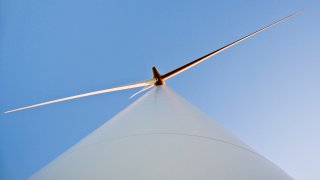
- MingYang Smart Energy says its MySE 16.0-242 wind turbine will have a capacity of 16 megawatts.
- With the scale of both turbines and offshore wind farms increasing, attempts are also being made to gain insight into how they interact with the marine environment.
MingYang Smart Energy has released details of a huge new offshore wind turbine, with the Chinese company aiming to install a prototype in 2023 before starting commercial production the year after.
With a height of 264 meters (866 feet), a rotor diameter of 242 meters and a blade length of 118 meters, the scale of the MySE 16.0-242, as it's known, will be considerable.
In a statement at the end of last week, MingYang said the turbine would have a capacity of 16 megawatts and be able to produce 80,000 megawatt hours of electricity per year, which it claimed would be enough to power over 20,000 households.
Get Tri-state area news and weather forecasts to your inbox. Sign up for NBC New York newsletters.
MingYang is one of several companies attempting to scale-up the size of offshore wind turbines. GE Renewable Energy's Haliade-X turbine, for example, will have a tip-height of 260 meters, 107-meter long blades and a 220-meter rotor.
Its capacity will be able to be configured to 12, 13 or 14 MW. A prototype of the Haliade-X, in the Netherlands, has a tip-height of 248 meters.
Elsewhere, Vestas has revealed plans for a 15 MW turbine, while Siemens Gamesa Renewable Energy is working on a 14 MW model, the SG 14-222 DD, which can also be boosted to 15 MW if required.
Money Report
As technology develops, the size of turbines is increasing. In a report published earlier this year, industry body WindEurope said the average rated capacity of turbines installed in Europe last year was 8.2 MW, a 5% increase on 2019. Capacity refers to the maximum amount a turbine can produce, not necessarily what it's currently generating.
China remains heavily reliant on fossil fuels but it is also becoming a powerhouse in offshore wind. According to data from GWEC Market Intelligence, China installed more than half the planet's offshore wind capacity last year.
With the scale of both turbines and offshore wind farms increasing, attempts are also being made to gain insight into how they interact with the marine environment. On Monday, a £7 million ($9.58 million) research program called ECOWind was launched in a bid to expand knowledge on the issue.
The four-year initiative is being headed up by the U.K.-based Natural Environment Research Council in partnership with The Crown Estate and the U.K. government's Department for Environment, Food and Rural Affairs.
In a statement The Crown Estate, which is owned by the Queen and manages a huge portfolio of land, said ECOWind would "fund leading edge research into how offshore windfarms affect the marine environment alongside other growing pressures on UK ecosystems including climate change and human activities such as fishing."
Susan Waldron, who is the NERC's director of research and skills, added that the collaborative program would "analyse the ecological consequence of large-scale expansion of offshore windfarms to inform future policy decisions throughout UK waters."






